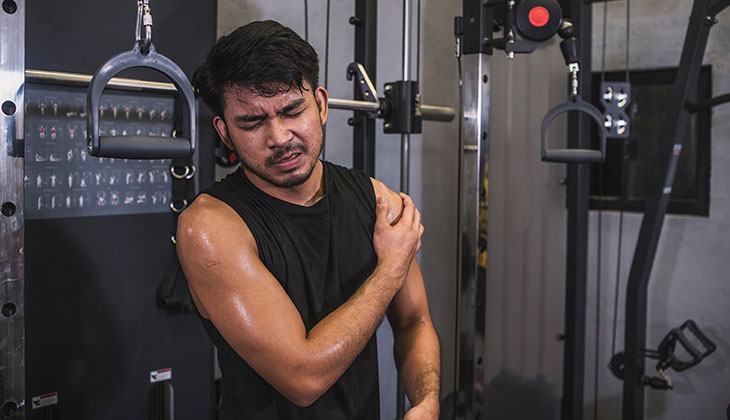
A torn rotator cuff is a common shoulder injury. It happens when at least one of the rotator cuff tendons is torn and becomes partially or fully detached from the bone.
This injury can weaken your shoulder and make it more difficult to perform everyday activities. There are several options for treatment, depending on how severe the tear. Our orthopaedic surgeon Ryan Freshman explains what you might feel if you have a torn rotator cuff, treatment options and more.
What does it feel like to have a torn rotator cuff? What are some symptoms of a torn rotator cuff?
A torn rotator cuff often feels like a deep, aching pain in the shoulder, which can worsen at night or when lying on the affected side. Some common symptoms include:
- Pain when lifting or lowering your arm
- Weakness when using the shoulder
- Limited shoulder range of motion
- Difficulty with tasks such as reaching for items a shelf or putting on your belt or bra
Check out our Sports Medicine Orthopaedic Services
What can cause a torn rotator cuff? What are the most common activities that can lead to a torn rotator cuff?
A torn rotator cuff can result from gradual wear and tear (age-related degeneration) or a sudden injury such as a fall onto your shoulder or arm. Common activities that can lead to a torn rotator cuff are heavy lifting and repetitive overhead movements. This could include overhead labor, swimming, tennis and baseball.
Schedule an appointment with our rotator cuff experts
How do you diagnose a torn rotator cuff?
A torn rotator cuff is diagnosed through a combination of a physical exam and medical imaging. Your health care provider will typically check your strength and range of motion. They also may perform exam maneuvers to specifically test for a torn rotator cuff.
X-rays can detect other possible causes of shoulder pain, including fractures and arthritis. A suspected rotator cuff tear can be confirmed by an MRI or ultrasound.
Explore our Sports Medicine and Sports Performance services
Can a torn rotator cuff heal itself?
While a torn rotator cuff is unlikely to heal without treatment, patients often see improvements in their pain, range of motion, weakness and shoulder function with non-surgical treatments. However, if non-surgical treatments don't help restore your normal function, you may need to discuss surgical options with an orthopaedic surgeon.
What are the treatment options for a torn rotator cuff?
Treatment options depend on the severity of the tear and whether your surgeon determines if it can be repaired. There are several non-surgical and surgical options for a torn rotator cuff.
Non-surgical options typically include:
- Rest and activity modification
- Physical therapy to strengthen shoulder muscles
- Pain management (such as anti-inflammatory medications and corticosteroid injections)
Severe rotator cuff tears, or those that don't improve with non-surgical treatment, may be treated with surgery.
For repairable rotator cuff tears, surgery can help reduce pain and restore motion. For irreparable tears (those that are too torn or degenerated), there are several options, including:
- Tendon transfer: This procedure involves moving another tendon around your shoulder to replace the torn tendon. It helps restore shoulder motion and strength.
- Reverse shoulder replacement: This procedure involves replacing the shoulder with a metal prosthesis. The replacement allows the shoulder to move better despite non-functioning or torn rotator cuff tendons.
Sign up for our Health Highlights e-newsletter
How long does it take for a torn rotator cuff to heal without surgery?
For minor tears, healing can take 6 to 12 weeks with a combination of physical therapy, medication and lifestyle modifications. More severe tears may take several months to heal and might not fully heal without surgery.
Learn about our rehab services for rotator cuff tears
How painful is recovery from rotator cuff surgery?
While pain varies by person, most patients experience moderate to severe pain in the first few days to weeks after surgery. Pain management options post-surgery include:
- Nerve block before surgery
- Prescription medications
- Keeping the arm in a sling so it doesn't move
- Ice therapy
- Rest
What are the downsides of rotator cuff surgery?
Some potential downsides of rotator cuff surgery include:
- Lengthy recovery that takes several months
- Risk of post-surgery stiffness and weakness
- Risk of complications (such as infection, re-tear, or nerve damage)
- No guarantee to completely eliminate pain or restore full strength/function
How long does it take to recover from rotator cuff surgery?
Recovery after rotator cuff surgery typically takes 4 to 6 months. Full strength and mobility usually return between 6 and 12 months, depending on the severity of the tear and how the patient progresses with rehabilitation.
How can I see a specialist at UC Davis Health to discuss rotator cuff treatments?
Your primary care provider can refer you to an orthopaedic specialist at UC Davis Health. Once you schedule an appointment, our specialists can help determine which rotator cuff treatment is right for you.
Learn how to schedule an appointment and get a referral
This blog was written by orthopaedic surgeon Ryan Freshman. He sees patients at the C Street Sports Medicine Clinic in Sacramento, as well as the Edwards Family Athletics Center in Davis, Calif.




